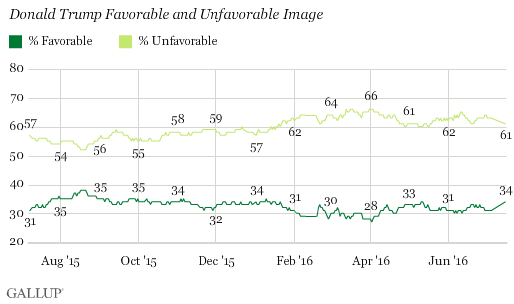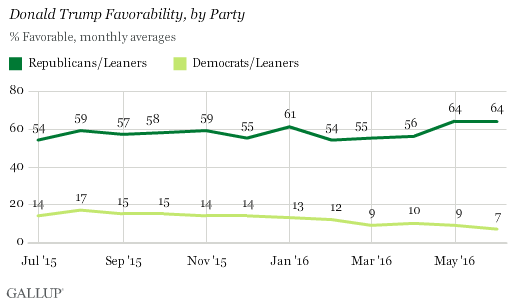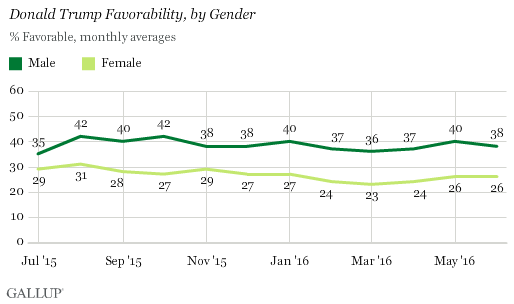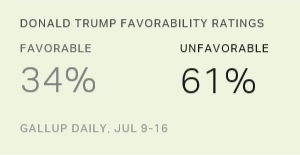Story Highlights
- Americans' favorable views of Trump at 34% now; 31% a year ago
- Trump's unfavorable also very similar now and in July 2015
- 66% of Republicans view Trump favorably
PRINCETON, N.J. -- As Republicans gather in Cleveland and prepare to make Donald Trump their party's presidential nominee, a retrospective analysis shows that Americans' views of Trump have been generally stable and continually negative over the past year. Despite some ups and downs as the campaign progressed, Trump's current 34% favorable and 61% unfavorable ratings are within a few percentage points of where they were in July 2015 when the campaign was just starting.

When Gallup began tracking Trump's favorability in July 2015, 31% of Americans viewed him favorably and 57% viewed him unfavorably, leaving 12% who had no opinion. The general trajectory of his image from that point through April this year has been negative, with his unfavorable rating rising to its high point of 66% several times in March and April. As it became increasingly evident that Trump would win his party's nomination, Trump's negative rating began to edge down slightly, ending at 61% for the last seven days ending July 16.
Trump's favorable rating was at its highest point of 38% in August 2015. His current 34% rating is higher than the lowest point of 27% in April 2016. Trump's overall favorable rating over the past 12 months has been 33%, while his average unfavorable rating has been 59%, meaning that his current image is just about average for the entire year.
Trump's current 61% unfavorable rating is among the most negative of any presidential candidate for whom Gallup has historical records on this question. Businessman Ross Perot, who ran as an independent candidate in 1992, had an unfavorable rating of 66% among registered voters in October of that year. Incumbent president and candidate George H.W. Bush's unfavorable rating reached as high as 57% during that same month. Candidates since 1992 have all had significantly lower unfavorable ratings.
Republicans Now a Bit More Positive About Trump
A little less than two-thirds of Republicans viewed their presidential nominee favorably in Gallup's June average, and that percentage is up slightly for the week ending July 16. Republicans' positive views were generally below the 60% mark until Trump essentially secured the nomination, and their ratings have edged higher since. Democrats' already low favorable opinions of Trump have drifted even lower as the campaign progressed, with a monthly high point of 17% in August 2015 and the low point of 7% in June 2016.

Trump's Favorable Image Among Blacks and Hispanics Between 10% and 12%
Trump's image is highly differentiated across the nation's racial and ethnic groups. Although still relatively low, his favorable rating among non-Hispanic whites over the past 12 months have been generally more than twice as high as his favorable rating among either blacks or Hispanics. The month-to-month favorable ratings among whites have ranged between a high of 44% last August to a low of 38% in March and April 2016. Blacks' favorable views of Trump have slid from 21% last August to 10% over the past two months. Hispanics' favorable views dropped to 12%.

Men Consistently More Positive Than Women About Trump
Most Republican candidates are better liked by men than by women, and Trump is no exception. The gender gap has averaged 12 percentage points over the past 12 months and was at exactly that average in June -- 38% of men held a favorable opinion, compared with 26% of women. The gender gap is slightly smaller over the seven days of interviewing ending July 16, however, at nine points. Trump's most recent seven-day average of 29% favorable rating among women is exactly the same as where he started last summer.

Bottom Line
The process by which non-politician Trump captured his party's presidential nomination will likely stand as one of most remarkable in contemporary U.S. political history. The billionaire businessman defied much of the conventional political logic about how to win a nomination, freewheelingly said things and criticized groups who previously had been off limits to major party candidates, used social media and avoided traditional paid television commercials. He won the nomination even as many professional politicians, media commentators and pundits said he had no chance.
Throughout the process, the audience to which Trump is ultimately playing -- the American people -- has ended up rating him just about how they did a year ago. When Gallup began tracking his image last July, it was just a shade less than a negative 2-to-1 ratio, and 12 months later, it is about the same. This stability raises the question of whether it is possible for Trump to change the way the people view him in the less than four months remaining in the campaign. If not, how possible will it be to convince Americans who don't like him in general to, nevertheless, end up voting for him?
The Republican National Convention now underway offers one of the best opportunities for a candidate like Trump to alter his image, as most candidates come out of their convention with a more positive standing than when it began.
Trump's candidacy thus far is credited with having created records for Republican primary voting turnout and primary debate ratings. This certainly suggests that the at-home audience for the GOP convention in Cleveland this week may be large, thus giving Trump one of the most important stages of his nascent political career so far.
Historical data are available in Gallup Analytics.
Survey Methods
Results for this Gallup poll are based on telephone interviews conducted July 9-16, 2016, on the Gallup U.S. Daily survey, with a random sample of 3,538 adults, aged 18 and older, living in all 50 U.S. states and the District of Columbia. For results based on the total sample of national adults, the margin of sampling error is ±3 percentage points at the 95% confidence level. All reported margins of sampling error include computed design effects for weighting.
Each sample of national adults includes a minimum quota of 60% cellphone respondents and 40% landline respondents, with additional minimum quotas by time zone within region. Landline and cellular telephone numbers are selected using random-digit-dial methods.
Learn more about how the Gallup U.S. Daily works.




